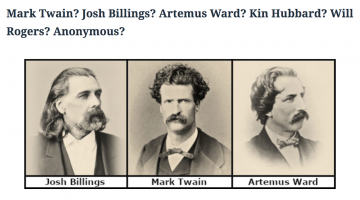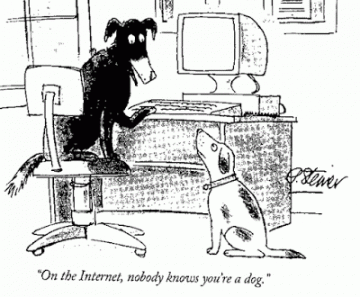The Critical Role of Digital Mentorship: Teaching in a World surrounded by “Fake News” Prezi
In the age of information, the internet and digital technology have changed the boundaries of education. Finding information online is a great tool for student-led learning, but also a dangerous one. Before our students can access the power of digital information, they need to understand how it can also mislead and manipulate their thinking. An increase in online accessibility has made the digital landscape far more complex and also easier to influence through the diffusion of false stories. Although access to digital resources remains an important equity issue, digital information has never been more popular, making digital literacy an essential subject in the school curriculum. With the rise of “Fake News” in our everyday life, how can we tell the difference between fact and fiction?
Digital literacy is the skills and abilities to critically navigate through the digital landscape by discerning online information. We are bombarded with news and information feeds 24/7, how do we know what is true and what is false? The creation of fake news comes from the intent of spreading false and misleading information for click-bait to capture attention and profit from advertisements. As people fall for and start to share false information it creates a vicious cycle. Circular reporting happens when information of just one source is made to look like it’s coming from multiple sources, making it seem valid. How do we avoid falling into circular reporting, which only contributes to the spread of “Fake News”? As the term “Fake News” has become everything from political agendas to conspiracy theories, the first step is to understand the difference between disinformation and misinformation.
Librarians from the University of Michigan explain how “Fake News” exists within a larger ecosystem of mis- and disinformation. Disinformation is false information that is deliberately created and spread in order to manipulate, influence public opinion or even obscure the truth. While misinformation is false or inaccurate information that is mistakenly or inadvertently created or spread; the intent is not to deceive, it is seen as a mistake. Through misinformation we spread disinformation, that is why our students need to think critically about online sources and evaluate where they get their information from. We have to motivate our students to seek out fact-checks and to ensure they have the digital literacy skills and abilities to evaluate information and find trustworthy answers.
Media literacy has always required a good eye for reliable sources and the willingness to dive deep into a source and determine what is true and what isn’t. But the internet isn’t an open library. It’s a predetermined experience. Algorithms powering search engines and social media timelines often choose what we see, tailoring our browsing experience based on our search histories. Algorithms serve the purpose of showing us content or ads that closely align with our interests, but they can also push information our way. Media hacking increases the visibility of ideas, stories and or even movements. With the hope that circular reporting of this false breaking news will leads to the continuous sharing of misinformation. Multiple studies suggest that Facebook is the single largest gateway to “Fake News,” so how can we find and remove bias and lies from our news feed? The C.R.A.P.2 test could help solve this question.
The C.R.A.P.2 is an adaptation of the model first created by Molly Beestrum and Kenneth Orenic at Dominican University. It is a helpful tool to use when trying to decide if a website is a credible, valid source. The C.R.A.P.2 Test is a list of criteria to help you evaluate the information you find. Different criteria will be used more or less important depending on the information you encounter. Below find the criteria to get into deeper C.R.A.P.!
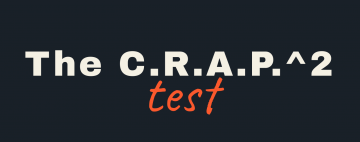
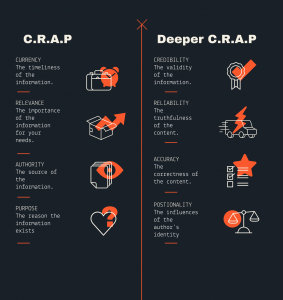

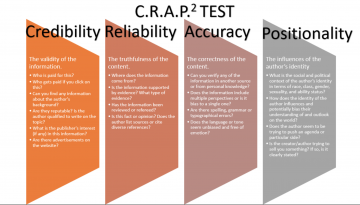
A great digital tool that can help you identify false information is Checkology. This renowned resource from the News Literacy Project is helping everyone to be more judicious and educated when it comes to understanding bias. The Checkology virtual classroom is a browser-based platform where middle school and high school students learn how to navigate today’s challenging information landscape by developing news literacy skills. Through its lessons, educators equip their students with tools to evaluate and interpret information and to determine what they can trust, share and act on. Digital journalism teacher David Teeghman leads his students at Michele Clark Academic Prep Magnet High School in Chicago through the “Misinformation” lesson on Checkology. Watch below!
Digital literacy is more than identifying misinformation and disinformation; it means being able to critically assess the news, call out false information and participate meaningfully in online communities by stopping the spread. Digital literacy becomes a civic act! Sometimes disinformation is posted deliberately to promote a political agenda. Bots, cyber-attacks and the spread of “Fake news” have completely dominated elections around the world. During the last four years, citizens of countries like Mexico, Brasil, U.S.A. & Canada have profoundly altered what they believe and how they behave—socially, politically and economically their countries. Over time, this manipulation has the power to destabilize our democracy. In this shocking clip from The Great Hack, we hear about the Cambridge Analytica campaign that was devised and successfully deployed in Trinidad and Tobago to alter the youth vote and ultimately influence an election result.
They took our data, can they take our control? The Great Hack uncovers the dark world of data exploitation through the scandal of Cambridge Analytica/Facebook. With companies like these, how can we protect ourselves from falling for disinformation and misinformation when it can be hidden in the core of our knowledge? The controversial book Three Cups of Tea by Greg Mortenson is another example. The author tapped into the good intentions of people with the idea that western schooling systems can prevent wars in the Middle East. Through the manipulation of fake hero stories and crooked charity foundations, he obtained donations from the U.S. government and every soldier that went to Afghanistan was given a copy of his book. The vision of education “particularly in the developing world is more of enculturation than is about the transmission and knowledge” (Davis, 2014).
Most western schooling systems ignore the scientific contributions of Indigenous knowledge holders. We are schooled in a settler dominant perspective of knowledge where there is the “implicit assumption that non-western science is not really science.” (Sarukkai, 2014 p. 1695). We are schooled in a system that continues to spread disinformation and misinformation. Another example is the story of Mexican Curandera, Maria Sabina, how her contribution to Ethnobotany is completely ignored by the scientific world and the “discovery” of psychedelic mushrooms is attributed to a Harvard Professor instead. Maria Sabina was the first Mexican Curandera to allow outsiders to participate in a sacred ritual that dates back to pre-Columbian times. Scientists took the opportunity to collect spores and analyzed their psychedelic properties because of her teachings (Estrada, 1989). The traditional use in rituals continues to be guided by Curanderas or Shamans, until this day. And finally, if there is going to be any credit for the use of psychedelic mushrooms in western science the recognition should be given to Maria Sabina.
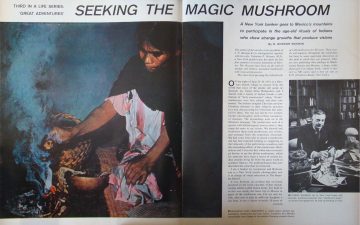

The lack of acknowledgment of the use of the mushrooms in Ancient Mesoamerican civilizations should not go unnoticed. Psychedelic mushrooms were known to the Aztecs as teōnanācatl from Nahuatl meaning “divine mushroom” which comes from teōtl “god or sacred” and nanācatl “mushroom”. (Dakin, 1982) They were used in sacred rituals and involved a deep spiritual consciousness reflection to serve the wellbeing of the community. Accrediting the discovery of psychedelic mushrooms to western science only for collecting spores is a big part of the settler problem and the reason we continue to be colonized. We have to start questioning where our information comes from and review the knowledge we believe to have. Our information is biased, it tells only one side of the story. For that, knowledge should never be seen as unproblematic.
Truth is perspective, it lies on the lens of the beholder. By understanding multiple perspectives of other people’s truths we augment our lens, we build our own truth. Knowledge is not a single truth to be acquired, but the process to find what truth means to you. For that, knowledge should never be seen as unproblematic. We have to be critical to our own thinking while engaging in an inquiry against biased systems that maintain the status quo. My role as NITEP’s digital peer mentor has shown me how digital information can manipulate outcomes. The importance of understanding where our knowledge comes from and who does our education benefit, to open a critical eye in your thinking and unveil multiple perspectives that question your current assumptions. We are teaching in a world surrounded by “Fake News,” freeing our learning is the only way to stop the spread. In a digital world where information is at the tip of our fingers and anyone can have a voice, we have to be critical of the voice we choose to listen to.
“It isn’t what we know that gives us trouble, it’s what we know that ain’t so.” Will Rogers

